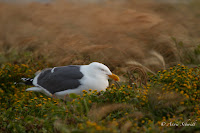
the fragrance of blooming weeds,
the fetid whiff of marine mammals,
the ambrosial scents of a Sunday brunch,
the putrid smells of seabird guano, the tantalizing aroma of Jen’s fresh baked chocolate chip cookies, and many more. But, of all the myriad smells we experience daily on this island, my favorite is a dirty musk that fills my nose when I enter the Habitat Sculpture, crouch down near a small rock crevice, or sweep the northeast corner of the Carpentry Shop. I like it because it reminds me of an Ashy Storm-petrel…
 |
| Ashy Storm-petrel |
 |
| Western Gulls amongst the grassy hillside |
Ashy’s are found only between S. Oregon and N. Mexico and are a species of special conservation concern in California due to a small global population. In fact, half the world’s population of this diminutive seabird lives on the Farallones, making the Farallones a critical colony for monitoring and conserving this species. Unfortunately, the Ashy population significantly declined since the 1970’s when PRBO began monitoring them on SEFI and the future status of this species remains uncertain. Like most seabirds, Ashy’s are vulnerable to the effects of a changing ocean climate which may affect the abundance and distribution of their primary food, mostly krill and other small zooplankton. Other major threats to Ashy’s on SEFI include predation by Burrowing Owls and Western Gulls and habitat change, specifically increases in non native grasses.
 |
| Ashy Storm-petrel at sea |
Most of my work on SEFI is accomplished during the daylight hours, but, last week, for the first time this season, we also did night work. The crew worked until a grueling 2:00AM mist-netting for Ashy Storm-petrels. Because these birds are primarily nocturnal when they are at the colony, this is the only way that we can capture and band them. By banding Ashy Storm-petrels PRBO hopes to determine population size, status and survival of adult birds. To attract Storm-petrels to the mist net we played vocalization of adult birds, you can listen to an Ashy vocalization by clicking below:
Lying down on a bed of rocks beside the net we waited for the birds to fly in. Ashy’s can wriggle out of the net pretty quick so once in we rushed to extract them. My first Ashy extraction went smoothly. And while the Ashy’s bite did not leave a mark like the Cassin’s Auklet, the Ashy did regurgitate a highly concentrated oil that left my hands reeking of the remindful musky odor. This oil is an important nutrient rich food for their chicks. The night brought us a total of 28 Ashy Storm-petrels including one recapture.
 |
| Storm-petrel burrow |
Later this season I will help study the breeding success of Ashy’s on SEFI. To do this I will suit up armed with a burrow camera, aka the SeeSnake, and traverse the island visiting known burrows. Ashy Storm-petrels nest in small cavities in rocks and crevice in some of the human created structures on the island. Each burrow is marked with a yellow stake and number. The holes are so tiny that we use the camera to peer in. We hope to find adult birds, eggs, or chicks.
 |
| Ashy Storm-petrel chick |














